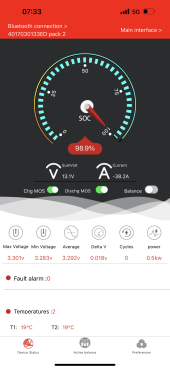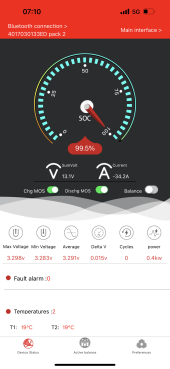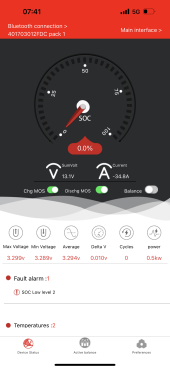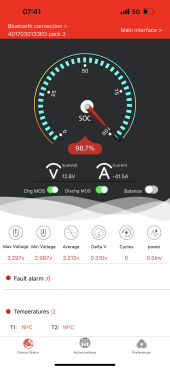HaraldK
New Member
Hi everyone!
I’m new at this forum and run into the following:
A few weeks ago I installed two Ninthcit LIFEPO4-battery banks in my sailing boat. They are connected in parallel. Each bank consists of 4 cells serial connected making it a 12v system and each bank has its own BMS.
I noticed that since a few days the amps consumed are unequally drawn from the battery banks and I can’t find the cause. For instance: if I use 78.5 Amps, one bank provides 44.1 amps and the other 34.4.
Also at lower consumption levels there is a difference. During last night one battery bank provided all 3 amps per hour and the other bank zero amps.
- I checked all the terminals to be clean, well fixed, etc.
- I switched the minus cable of both BMS’s to see if the difference is caused by one of them. The difference of each battery pack remains the same, only measured now by the other BMS. That kind of rules out that one of the BMS’s causes the problem.
- I switched the + cables from both battery packs, but made no difference to check if the internal resistance of the wires is different. Made no difference.
- the + cables as well as the - cables of both packs are of equal length, quality, age and thickness.
- It is a new battery system (few weeks) and until just a few days ago these differences were not occurring.
It seems preferable to me that both packs use the same amount of amps all the time.
My question is:
Is it usual that these differences occur?
If not, what can be causing the difference and what solution is there?
Looking forward to your replies.
Thanks!
I’m new at this forum and run into the following:
A few weeks ago I installed two Ninthcit LIFEPO4-battery banks in my sailing boat. They are connected in parallel. Each bank consists of 4 cells serial connected making it a 12v system and each bank has its own BMS.
I noticed that since a few days the amps consumed are unequally drawn from the battery banks and I can’t find the cause. For instance: if I use 78.5 Amps, one bank provides 44.1 amps and the other 34.4.
Also at lower consumption levels there is a difference. During last night one battery bank provided all 3 amps per hour and the other bank zero amps.
- I checked all the terminals to be clean, well fixed, etc.
- I switched the minus cable of both BMS’s to see if the difference is caused by one of them. The difference of each battery pack remains the same, only measured now by the other BMS. That kind of rules out that one of the BMS’s causes the problem.
- I switched the + cables from both battery packs, but made no difference to check if the internal resistance of the wires is different. Made no difference.
- the + cables as well as the - cables of both packs are of equal length, quality, age and thickness.
- It is a new battery system (few weeks) and until just a few days ago these differences were not occurring.
It seems preferable to me that both packs use the same amount of amps all the time.
My question is:
Is it usual that these differences occur?
If not, what can be causing the difference and what solution is there?
Looking forward to your replies.
Thanks!








